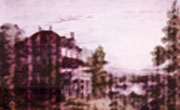
| teaching and creating |  |
|
|
FrankenMOO
Romantic Circles High School Module The Imaginary Spaces of Literature "I can hardly describe to you the effect of these books. They produced in me an infinity of new images and feelings, that sometimes raised me to ecstasy, but more frequently sunk me into the lowest dejections." --Frankenstein Skill Sets: This project helps students to see how authors build meaning in their texts by making allusions to other literary works. Students learn how to compare and contrast Shelley's novel with other literature. By seeing how Shelley handles her source texts, students learn how to intelligently incorporate someone else's ideas into their own work--a valuable skill for future student research projects. In fact, a research paper on Shelley's use of Wollstonecraft, Rousseau, Milton, or Paracelsus would be a fine follow-up project. Finally, just as the characters in the novel rely on books to help them understand their lives, students learn how the imaginative space of literature can help them think more clearly about themselves and their world. Project: Literature is a space of imagination where authors create other worlds sometimes similar and sometimes different from our own. Some of these places, called utopias, are ideal and almost perfect. Other places are dark and dreadful spaces, called dystopias. In Frankenstein, Mary Shelley has her characters read from different literary works in order to learn about themselves and their world or to help them imagine a different and sometimes better place. Additionally, the fictional spaces and people in Frankenstein help us think about our own very real world. Here is a list of literature Shelley borrows from in her novel. Books read by characters in
the novel include:
Some other books used by Mary
Shelley:
[Brief two to four page excerpts will be provided for students to read.] Step One: Shelley Using
Literature
Then, students should answer the following questions: 1. Does your assigned excerpt describe a beautiful world or a dismal world? Explain how this excerpt is a utopia or dystopia. 2. Find key sentences in Frankenstein that illustrate how Shelley alludes to the excerpt you are studying. How does Shelley use other literature to describe the world of her novel? How does the excerpt help you to understand Shelley's novel? 3. Some of the fiction Shelley uses is read by the characters in Frankenstein. Does the character like or dislike what he or she reads? What does the character learn from what he or she reads? How does the fiction help the character think about his or her life? Step Two: Creating a Fiction
Space in the MOO
Step Three: Filling in
Your Fiction Space
Make a fourth note called "Conclusion" in which your group summarizes your findings from step one question three (above). Step Four: The Space of
Literature
Just as the characters in the novel use literature to learn about their own lives, write a paragraph explaining what you learn about yourself by reading Frankenstein? Which character do you learn from most? Why?
|